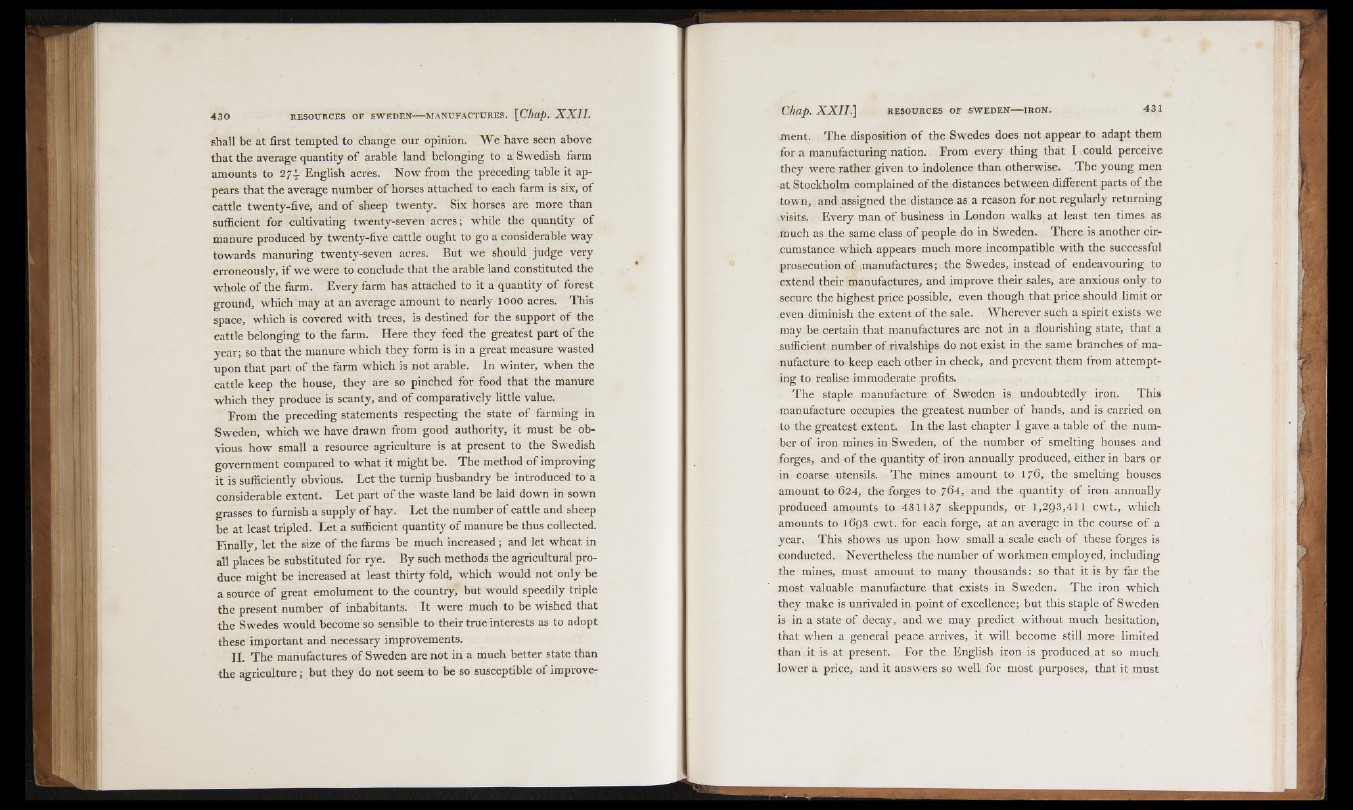
shall be at first tempted to change our opinion. W e have seen above
that the average quantity o f arable land belonging to a Swedish farm
amounts to 274. English acres. Now from the preceding table it appears
that the average number of horses attached to each farm is six, of
cattle twenty-five, and of sheep twenty. Six horses are more than
sufficient for cultivating twenty-seven acres; while the quantity o f
manure produced by twenty-five cattle ought to go a considerable way
towards manuring twenty-seven acres. But we should judge very
erroneously, i f we were to conclude that the arable land constituted the
whole o f the farm. Every farm has attached to it a quantity o f forest
ground, which may at an average amount to nearly 1000 acres. This
space, which is covered with trees, is destined for the support of the
cattle belonging to the farm. Here they feed the greatest part of the
year; so that the manure which they form is in a great measure wasted
upon that part of the farm which is not arable. In winter, when the
cattle keep the house, they are so pinched for food that the manure
which they produce is scanty, and of comparatively little value.
From the preceding statements respecting the state of farming in
Sweden, which we have drawn from good authority, it must be obvious
how small a resource agriculture is at present to the Swedish
government compared to what it might be. The method of improving
it is sufficiently obvious. Let the turnip husbandry be introduced to a
considerable extent. Let part of the waste land he laid down in sown
grasses to furnish a supply of hay. Let the number of cattle and sheep
be at least tripled. Let a sufficient quantity of manure be thus collected.
Finallv, let the size of the farms he much increased; and let wheat in
all places he substituted for rye. By such methods the agricultural produce
might be increased at least thirty fold, which would not only be
a source o f great emolument to the country, hut would speedily triple
the present number of inhabitants. It were much to be wished that
the Swedes would become so sensible to their true interests as to adopt
these important and necessary improvements.
II. The manufactures of Sweden are not in a much better state than
■the agriculture; but they do not seem to be so susceptible of improver
ment. The disposition o f the Swedes does not appear to adapt them
for a manufacturing nation., From every thing that I could perceive
they were rather given to indolence than otherwise. . The young men
at Stockholm complained of the distances between different parts of the
town, and assigned the distance as a reason for not regularly returning
visits. Every man o f business in London walks at least ten times as
much as the same class of people do in Sweden. There is another circumstance
which appears much more incompatible with the successful
prosecution of manufactures; the Swedes, instead o f endeavouring to
extend their manufactures, and improve their sales, are anxious only .to
secure the highest price possible, even though that price should limit or
even diminish the extent of the sale. Wherever, such a spirit exists .we
may be certain that manufactures are not in a. flourishing state, that a
sufficient number of rivalships do not exist in the same branches o f manufacture
to keep each other in check, and prevent them from attempting
to realise immoderate profits. .
The staple manufacture of Sweden is undoubtedly iron. This
manufacture occupies the greatest number of hands, and is carried on
to the greatest extent. In the last chapter I gave a table o f the number
of iron mines in Sweden, of the number o f smelting houses and
forges, and of the quantity o f iron annually produced, either in bars or
in coarse utensils. The mines amount to 176, the smelting houses
amount to 624, the forges to 764, and the quantity of iron annually
produced amounts to 4 3 1 13 7 skeppunds, or 1,293,411 cwt., which
amounts to 1693 cwt. for each forge, at an average in the course o f a
year. This shows us upon how small a scale each of these forges is
conducted. Nevertheless the number of workmen employed, including
the mines, must amount to many thousands: so that it is by far the
most valuable manufacture that exists in Sweden. The iron which
they make is unrivaled in point o f excellence; but this staple of Sweden
is in a state o f decay, and we may predict without much hesitation,
that when a general peace arrives, it will become still more limited
than it is at present. For the English iron is produced at so much
lower a price, and it answers so well for most purposes, that it must